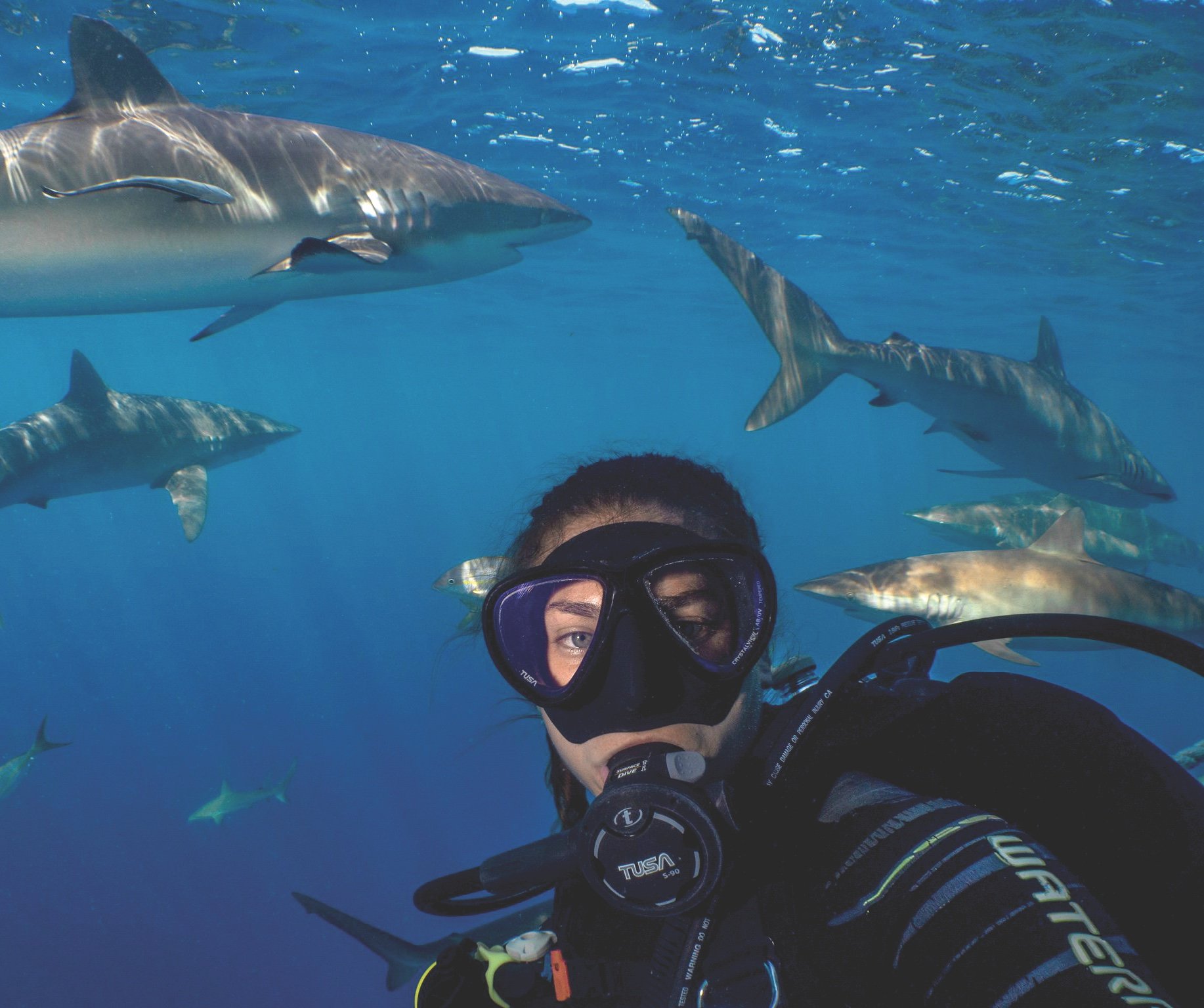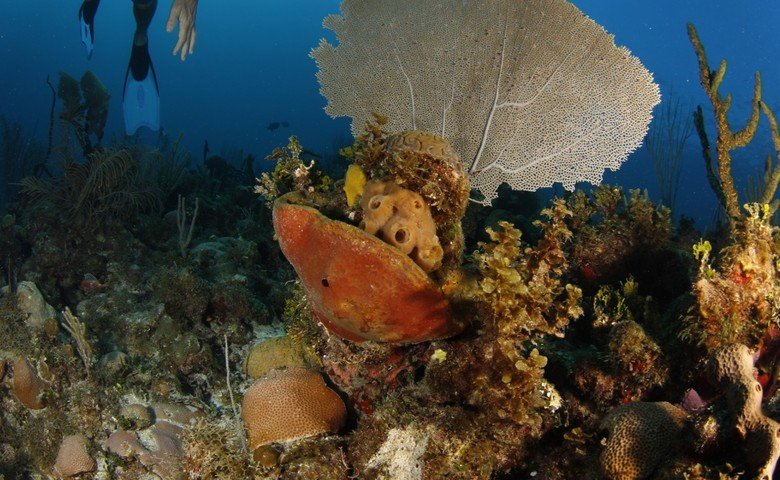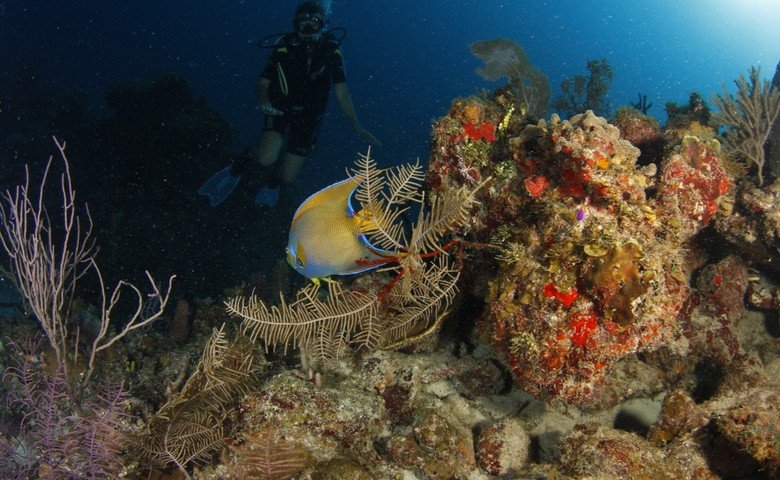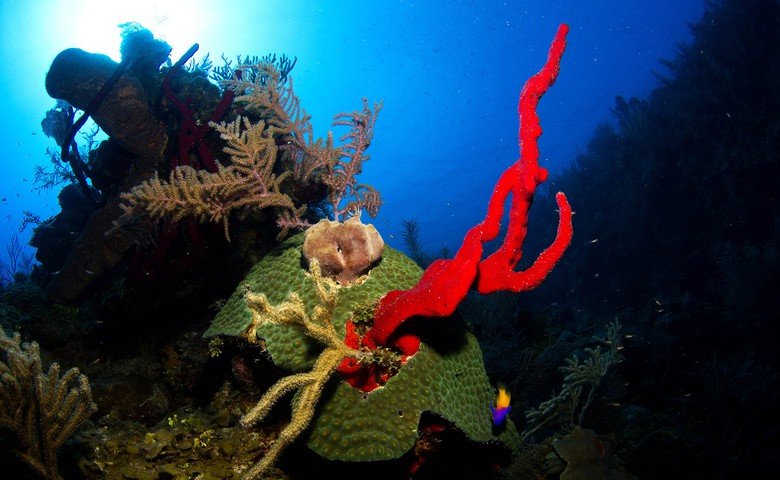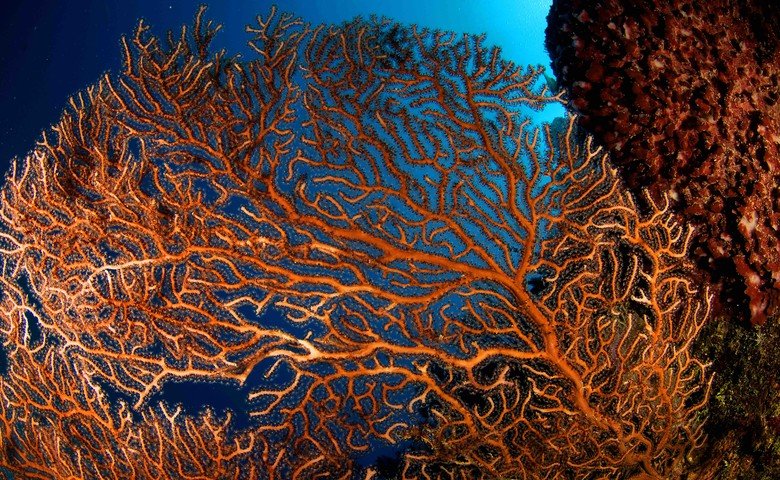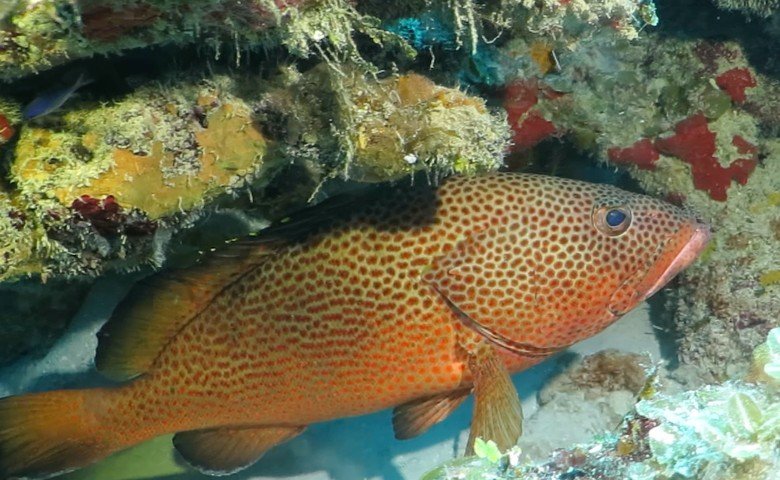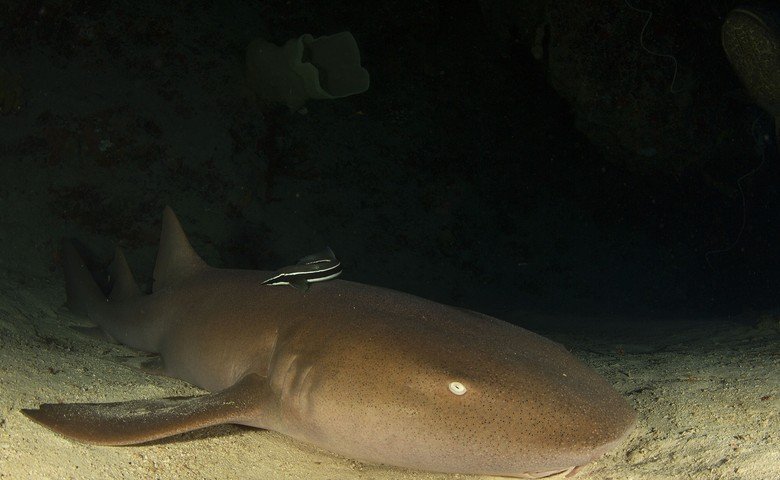Jardines de la Reina National Park, Cuba
OVERVIEW
Although 60% of the world's coral reefs are seriously endangered, there are still bright spots for ocean conservation - areas where reefs are thriving. Conserving these intact reefs is becoming more important than ever. One such place is Jardines de la Reina National Park, in Cuba.
Global Conservation is now using advanced surveillance technologies and SMART patrols to protect one of the Caribbean's last intact marine ecosystems.
SIZE
217,000 Hectares
GOAL
$640,000
VISITORS BY 2030
7,500
Introduction
It’s easy to forget that corals are animals, not minerals. These odd creatures are colonies of genetically identical polyps, tiny animals with tentacles and a mouth opening that defend themselves with a strong exoskeleton. A head of coral is something like a thousand millimeter-wide snails glued together, each with a protective shell that they can retract into. Over time, as the colony grows and more polyps build their exoskeletons, the coral expands. When thousands of these colonies of different coral species grow together, it creates a coral reef, an incredibly rich underwater ecosystem that sustains a panoply of invertebrates, fish, and marine mammals.
But those tiny coral polyps can’t survive alone. Most corals rely on energy and nutrients from even tinier, single-celled plankton that live inside of the polyps. Those plankton get their energy from the sun, passing some of what they make during photosynthesis to their coral hosts.
That relationship is key to why so many reefs are disappearing today. When corals get stressed, for example by rising sea temperatures or ocean acidification, they evict their plankton pals. Since the plankton give the coral its color, the corals then become white – what we know as coral bleaching. Bleaching produces a domino effect that slowly starves the reef, transforming it from a thriving ecosystem into a barren wasteland as coral polyps die. Some reefs can recover, while others don’t. Scientists are still trying to understand what makes reefs resilient to bleaching events.
As global temperatures rise, mass bleaching events will only become more common. The longest recorded coral bleaching in history happened between 2014 and 2016, damaging over 70% of the world’s coral reefs. Already, 50% of the world’s reefs are dead, and another 40% are in serious jeopardy.
However, there are still bright spots for ocean conservation - areas where reefs are thriving. Conserving these intact reefs is becoming more important than ever. One such place is Jardines de la Reina National Park, in Cuba.
Natural Heritage
Jardines de la Reina, sometimes called “Cuba’s Coral Garden”, is one of the last major intact marine protected areas (MPAs) in the Caribbean. This archipelago covers about 684,000 hectares in the Gulf of Ana Maria off the southern coast of Cuba.
This park is a testament to the power of protected areas: since Jardines de la Reina was protected in 1996, fish numbers have increased 30-50%, and it’s the last refuge for critically endangered sharks, groupers and sea turtles in Cuba. In fact, these reefs have ten times as many sharks and groupers as surrounding waters. The survival of these top-level predators is an excellent indicator of reef health, as they can’t thrive without healthy populations of prey. The national park is also home to other rare forms of life, such as marine mammals, three sea turtle species, queen conchs (a type of large mollusc), and extremely sensitive staghorn and elkhorn corals. The park also contains black corals, which are thought to be among the oldest organisms in the world; some are over 4,000 years old.
Jardines de la Reina contains a number of marine species that are listed by the IUCN as being in danger of extinction:
| Common Name | Scientific Name | IUCN Red List Status |
|---|---|---|
| Atlantic Goliath Grouper | Epinephelus itajara | Vulnerable (VU) |
| Nassau Grouper | Epinephelus striatus | Critically Endangered (CR) |
| Red Grouper | Epinephelus morio | Vulnerable (VU) |
| Black Grouper | Epinephelus nigritus | Near Threatened (NT) |
| Hawksbill Turtle | Eretmochelys imbricata | Critically Endangered (CR) |
| Green Turtle | Chelonia mydas | Endangered (EN) |
| American Crocodile | Crocodylus acutus | Vulnerable (VU) |
| Caribbean Reef Shark | Carcharhinus perezi | Near Threatened (NT) |
| Whale Shark | Rhincodon typus | Endangered (EN) |
| Sand Tiger Shark | Carcharias taurus | Vulnerable (VU) |
| Great Hammerhead Shark | Sphyrna mokarran | Critically Endangered (CR) |
| Hogfish | Lachnolaimus maximus | Vulnerable (VU) |
| Queen Triggerfish | Balistes vetula | Near Threatened (NT) |
| Rainbow Parrotfish | Scarus guacamaia | Near Threatened (NT) |
| Spotted Eagle Ray | Aetobatus narinari | Near Threatened (NT) |
"Jardines de la Reina" means Gardens of the Queen. This area was named by Christopher Columbus after Queen Isabella I of Spain.
Economic Value
Along the shore, labyrinthine mangrove forests are nurseries for young fish, protecting them as they grow. This pristine habitat is a wellspring of fish that helps populate surrounding areas, guarding this region against threats like overfishing and pollution. This is critical not only for Cuban fishermen, but also American ones: although relations between the US and Cuba have been historically frigid, the health of this marine ecosystem directly impacts the US’s southeastern fisheries. At their closest points, Cuba and Florida are separated by only 160 km of ocean. International borders are of little consequence to ocean life, and Jardines de la Reina’s vast mangrove forests sustain young fish that may eventually end up on dinner plates in Miami. Elsewhere in the Caribbean, mangrove forests have been destroyed. As a result, Florida’s fishing industry, marine tourism, and seafood supply rely on the productivity of Cuba’s waters.
Jardines de la Reina National Park is important to Cuba and the world because it:
Maintains biodiversity of endangered and commercial species for Cuba and its people;
Protects critical habitats from damage by destructive fishing practices and other human activities and allows them to recover;
Provides a large protected area where fish are able to reproduce, spawn and grow to their adult size;
Increases fish catches (both size and quantity) in surrounding fishing grounds;
Builds resilience to protect against damaging external impacts, such as climate change;
Helps to maintain local cultures, economies, and livelihoods which are intricately linked to the marine environment.
Threats to Jardines de la Reina
While the Cuban government has vowed to protect 25% of the nation’s waters as marine reserves, it remains to be seen whether Cuba can escape the rampant coastal development, overfishing, and other problems that have taken such a heavy toll on coral reefs elsewhere in the Caribbean.
As market demand increases for fish for Cuba’s tourism industry, Jardines de la Reina will face even greater pressures. Most of Cuba’s fisheries have already been overharvested, driving fishermen into illegally harvesting in the national park.
It’s estimated that over 300 private fishing boats are fishing illegally each day in or near the national park. To date, these vessels have been nearly impossible to identify and intercept. Traditionally, efforts to clamp down on illegal fishing have relied on aircraft and patrol vessels that are prohibitively expensive for even the richest of nations. Today, there are few patrol boats and no radar and other basic protection for the national park.
Our Objectives
To protect this pristine reef and its contribution to the Cuban economy, Global Conservation’s goal is to implement Global Park Defense to eliminate all poaching and illegal activities in Jardines de la Reina National Park within four to five years.
Our system uses relatively low-cost and readily available surveillance and communications technologies that together have the potential to revolutionize marine park protection for Jardines de la Reina and be a model for other marine protected areas in Cuba and the Caribbean.
Global Park Defense for Marine Protected Areas is a cutting-edge technology platform that combines video and radar monitoring to help park authorities detect suspicious fishing activity. Our primary objective includes implementation of the park protection network, including protection vessels, marine radars, long-range video cameras, and park-wide communications.
"Protecting Jardines de la Reina, truly the jewel of the Antilles, is a conservation gift to Cubans, the entire Caribbean and the planet. With so many marine habitats under pressure from overharvesting and climate change, preserving its pristine coral reefs and extensive seagrass beds is essential." -Julia Langer, Former Director, World Wildlife Fund
Throughout, we will work closely with local fishing communities on sustainable fishing practices in productive areas outside the Jardines de la Reina National Park.
Global Conservation and our partners are implementing Jardines de la Reina's first park protection system based on these key integrated components:
Long-Range Video: New long-range video technology can now identify the hundreds of small boats that are illegally poaching fish and lobster from within the national park. Boats entering the park can be identified and ranger patrols can use scarce patrol boats and fuel in a highly efficient manner for the first time.
Marine Radar: Low-cost marine radar systems will also be deployed in patrol boats to provide exact locations for interception of illegal boats within the marine protected area. Once an offending boat has been identified by long-range video or radar, patrol boats can easily track and intercept only those boats within the park boundaries, multiplying the effectiveness of patrols and scarce fuel.
Automatic Identification System (AIS) Surveillance: All government fishing trawlers working in the region are, or will be, equipped with GPS tracking and will be notified when they are close to or entering national park waters. These government-run fishing fleets take the greatest amount of fish and lobster from the area and can now easily be tracked to ensure compliance with park boundaries and the protected fisheries.
Microwave and Radio Communications: Microwave transmission and repeater equipment will be installed to enable real-time communications between the patrol stations on the Jardines de la Reina archipelago and the coast ranger patrol headquarters, 40-50 nautical miles away. By enabling wireless internet transmission of park protection data feeds and radio coverage for most of the national park and surrounding waters, patrol effectiveness will again be multiplied.
Park Protection Network: Global Conservation will implement a state-of-the-art marine protection system on the archipelago using video camera sensors, marine radar and organized patrols to actively monitor and enforce protection.
UAV Drone Surveillance: Global Park Defense uses drone technology for aerial monitoring, for a small fraction of the cost of a single flight using traditional manned surveillance aircraft. Conservation drones are equipped with the same capabilities of their military-class surveillance counterparts, at a far lower price point.
Command and Control: The new Jardines de la Reina command center will integrate all data feeds - video, radar and radio - into a single command and control dispatch system. This will allow rangers to effectively deploy and communicate during interdiction missions. Locations of illegal activities and evidence collection for ticketing and prosecution of offenders are also securely stored in a central database accessible by park rangers and enforcement staff.
Park Demarcation: Global Conservation is working to secure park boundary demarcation for the borders of Jardines de la Reina National Park using solar-powered GPS buoys on steel cables installed every five nautical miles. These park demarcation buoys align with park borders and provide visible notification that boats are encroaching on the national park. Clear park demarcation through buoys makes illegal encroachment visible to all boats and violators can be cited and prosecuted.
360-Degree View: Global Park Defense can synthesize and analyze multiple layers of data in near-real time to monitor and identify suspicious activities with a national park, with an automated system that alerts authorities so they can investigate and take action. Global Park Defense for MPAs is a cost-effective monitoring and enforcement tool for park authorities to monitor and detect illegal fishing and other harmful extraction activities.
We will be using baseline data and trend analysis to measure our success by monitoring:
Number of illegal entries
Number of interdictions and violation tickets
Fish population trends for critical species in target areas
Economic success of fisheries participating in sustainability programs
Jobs created by conservation initiatives
Improvements in standard of living and food security for local communities.
As reefs disappear globally, protected areas like Jardines de la Reina are becoming increasingly important. This reef is a living laboratory that can help scientists understand why some reefs are more resilient than others against global change. With strong protections, Jardines de la Reina might teach us how to save these undersea edens for generations to come.
The Opportunity
Despite these threats, Jardines de la Reina National Park offers a unique opportunity. These reefs are one of the most popular scuba destinations in Cuba, and visitors flock here to swim among the underwater canyons, pinnacles, and caves. There, they come face-to-face with some of the Caribbean’s most awesome predators, including silky and Caribbean reef sharks, goliath groupers the weight of a small car at almost 300kg, and even 3-meter American crocodiles among the mangrove labyrinth.
This existing sustainable marine tourism can fund the critically needed surveillance, protection and management, requiring only a relatively small additional investment in park protection systems and technology. It’s estimated that the currently permitted 2,000 divers and 1,000 sport fishing visitors generate nearly $10 million a year in revenues, of which over $1.5 million directly or indirectly support park protection. Over 360 well-paying jobs are a direct result of tourism, with hundreds of other jobs in related industries such as transport, logistics, and hospitality.
Partners in Conservation
Jardines de la Reina National Park has benefited greatly from local stewardship over the past 20 years under a unique public-private partnership between a highly successful diving and sports fishing concession (Avalon Cuban Diving Centers) working with park management (Empresa Nacional para la Protección de la Flora y la Fauna, or the National Body for the Protection of Flora and Fauna) and fishing inspectors (Ministerio de la Industria Pesquera, or the Ministry of Fisheries).
Global Conservation is providing critical know-how, technology, systems and organizational training for setting up and managing the park protection network, while our partners will each be contributing their critical components to achieve full protection and enforcement over the coming decades.
Other groups are currently working in scientific research and national marine protected area policy including CIEC, the Center for Coastal Ecosystems Research, and CNAP, the Center for National Protected Areas, which is responsible for national policies for parks and marine protected areas. Environmental Defense Fund (EDF) has given special emphasis to Jardines de la Reina in its work with the Government of Cuba to improve overall national policy, legal frameworks and training.













